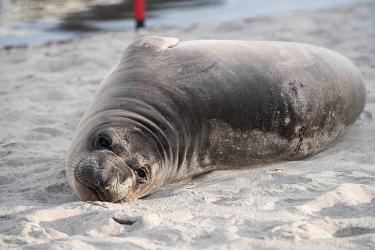We improve fishing community profiles and information and examine coastal human communities for their general social vulnerabilities and socioeconomic ties to the marine environment. This project has two main efforts:
Fishing Community Profiles
We engage in various means of profiling West Coast communities involved in commercial, recreational, and subsistence fishing, including using primary data collections (surveys of, and fieldwork with resident community fishers) and secondary data analysis (quantitative approaches applied to existing community data). We present individual community profiles in narrative text format, alongside comparable quantitative measures developed from port-level fisheries data and U.S. Census demographics data. We provide West Coast community profiles in print form and via web-based content, wherein individual constituent measures may be downloaded at multiple geographic scales.
Fishing Community Vulnerability Analysis
We develop indices measuring individual coastal communities' fishing reliance, poverty levels, demographics, and other data categories. These indices allow us to characterize communities based upon their links to marine natural resources, socioeconomic vulnerabilities, and resilience capacities in response to socioeconomic and environmental change.
A multiple factor analysis approach applied to a nationally established range of indices and data sources for coastal communities allow for vulnerability analysis and West Coast-wide community comparisons, which are updated annually as each year's new data become available. The coastal Community Social Vulnerability Indicators (CSVI) analyses feature in annual iterations of the California Current Integrated Ecosystem Assessment. These indices also provide policy-makers information about social impact assessment needs for a range of fisheries-oriented management and environmental change scenarios.
The resultant Community Social Vulnerability Indicators (CSVI) for West Coast communities are consistent with a national approach to community metrics. They are included in national reporting on fishing communities for all NOAA Fisheries regions. We also develop regionally specific indicators for West Coast communities, which account for unique regional aspects of recreational fishing data and management needs and questions centered on fisheries concentration in West Coast communities. A more expansive conceptualization of human wellbeing within fishing communities has also featured in our joint efforts to provide methods for assessing additional social indicators, including community indicators of fisher health and community governance.
Related Publications
Breslow, S. J., A. Margaret, D. Holstein, B. Sojka, R. Barnea, X. Basurto, C. Carothers, S. Charnley, S. Coulthard, N. Dolsak, J. Donatuto, C. Garcia-Quijano, C. Hicks, A. Levine, M. B. Mascia, K. C. Norman, M. R. Poe, T. Satterfield, K. St. Martin, P. S. Levin. 2017. Evaluating Indicators of Human Wellbeing for Ecosystem-Based Management. Ecosystem Health & Sustainability, (12). doi:10.1080/20964129.2017.1411767
Colburn, L., M.l Jepson, A. Himes-Cornell, S. Kasperski, K. Norman,C. Weng and P. M. Clay. 2017. Community Participation in U.S. Catch Share Programs. U.S. Dept. of Commer., NOAA. NOAA Technical Memorandum NMFS-F/SPO-179, 136 p.
Harvey, C., N. Garfield, G. Williams, N. Tolimieri, I. Schroeder, E. Hazen, K. Andrews, K. Barnas, S. Bograd, R. Brodeur, B. Burke, J. Cope, L. deWitt, J. Field, J. Fisher, T. Good, C. Greene, D. Holland, M. Hunsicker, M. Jacox, S. Kasperski, S. Kim, A. Leising, S. Melin, C. Morgan, B. Muhling, S. Munsch, K. Norman, W. Peterson, M. Poe, J. Samhouri, W. Sydeman, J. Thayer, A. Thompson, D. Tommasi, A. Varney, B. Wells, T. Williams, J. Zamon, D. Lawson, S. Anderson, J. Gao, M. Litzow, S. McClatchie, E. Ward, and S. Zador. 2018. Ecosystem Status Report of the California Current for 2018: A Summary of Ecosystem Indicators Compiled by the California Current Integrated Ecosystem Assessment Team (CCEIA). U.S. Department of Commerce, NOAA Technical Memorandum NMFS-NWFSC-145. https://doi.org/10.25923/mvhf-yk36
Norman, K. C., J. A. Sepez, H. Lazrus, N. Milne, C. Package, S. Russell, K. Grant, R. Petersen Lewis, J. Primo, E. Springer, M. Styles, B. D. Tilt, I. Vaccaro. 2007. Community profiles for West Coast and North Pacific fisheries - Washington, Oregon, California, and other U.S. states. U.S. Dept. of Commerce, NOAA Tech. Memo., NMFS-NWFSC-85, 602 p
Norman, K. C., T. G. Safford, B. E. Feist, M. Henly. 2016. At the confluence of data streams: mapping the social and biophysical landscapes on the Puget Sound's edge. Coastal Management, 44(5):427-440. doi:10.1080/08920753.2016.1208038
Pitchon, A. and K. Norman. 2012. Fishing off the Dock and Under the Radar in Los Angeles County: Demographics and Risks. Bulletin of the of Southern California Academy of Sciences, Dec 111(2): 141-152
Sepez, J. A., K. C. Norman, B. D. Tilt, A. Poole. 2006. Fish scales: scale and method in social science research for North Pacific and west coast fishing communities. Human Organization, 65(3): 280-294
Sepez, J. A., K. C. Norman, R. Felthoven. 2007. A Quantitative Model for Ranking and Selecting Communities Most Involved in Commercial Fisheries. National Association for the Practice of Anthropology Bulletin, (28): 43-57
Speir, C., C. Ridings, J. Marcum, M. Drexler, K. Norman, 2020. Measuring health conditions and behaviours in fishing industry participants and fishing communities using the Behavioral Risk Factor Surveillance Survey (BRFSS), ICES Journal of Marine Science, In Press
Contact


